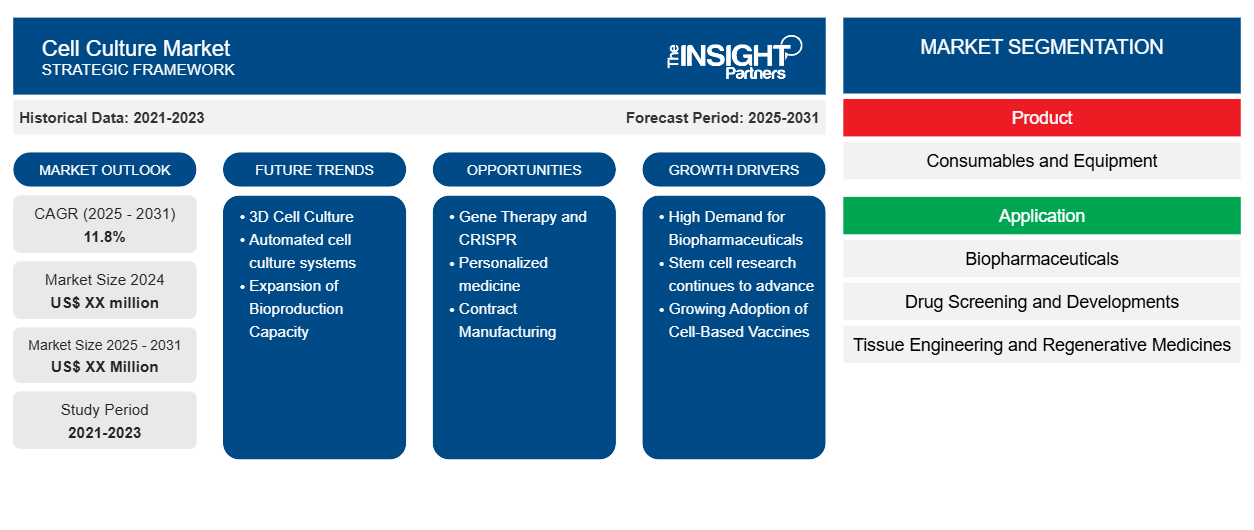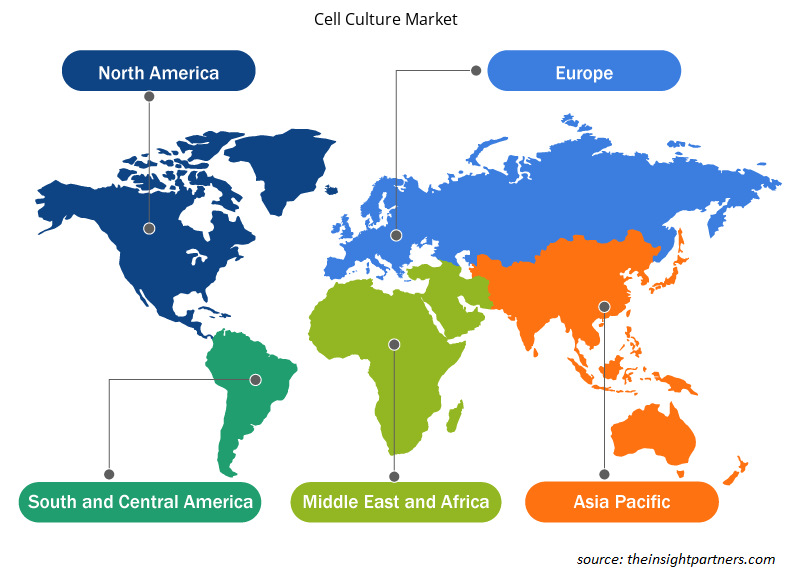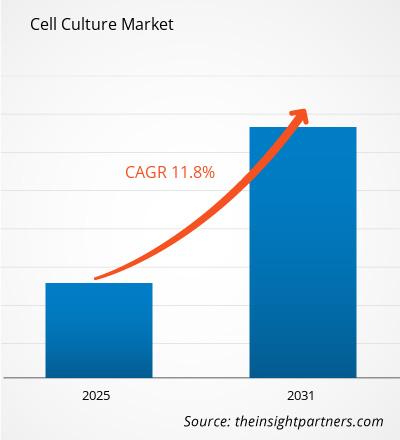The Cell Culture Market is expected to register a CAGR of 11.8% from 2025 to 2031, with a market size expanding from US$ XX million in 2024 to US$ XX Million by 2031.
The Cell Culture Market is categorized by product into the following subsegments: Consumables, Equipment. It further presents an analysis based on application, i.e., Biopharmaceuticals, Drug Screening and Developments, Tissue Engineering and Regenerative Medicines, Diagnostics, and Others; and end user, i.e., Pharmaceutical and Biotechnology Companies, Hospitals and Diagnostic Laboratories, Research and Academic Institutes, and Others. The global analysis is broken down at the regional level and major countries. The market evaluation is presented in US$ for the above segmental analysis.
Purpose of the Report
The report Cell Culture Market by The Insight Partners aims to describe the present landscape and future growth, top driving factors, challenges, and opportunities. This will provide insights to various business stakeholders, such as:
- Technology Providers/Manufacturers: To understand the evolving market dynamics and know the potential growth opportunities, enabling them to make informed strategic decisions.
- Investors: To conduct a comprehensive trend analysis regarding the market growth rate, market financial projections, and opportunities that exist across the value chain.
- Regulatory bodies: To regulate policies and police activities in the market with the aim of minimizing abuse, preserving investor trust and confidence, and upholding the integrity and stability of the market.
Cell Culture Market Segmentation
Product
- Consumables and Equipment
Application
- Biopharmaceuticals
- Drug Screening and Developments
- Tissue Engineering and Regenerative Medicines
- Diagnostics
- Others
End User
- Pharmaceutical and Biotechnology Companies
- Hospitals and Diagnostic Laboratories
- Research and Academic Institutes
- Others
Geography
- North America
- Europe
- Asia-Pacific
- South and Central America
- Middle East and Africa
You will get customization on any report - free of charge - including parts of this report, or country-level analysis, Excel Data pack, as well as avail great offers and discounts for start-ups & universities
Cell Culture Market: Strategic Insights

- Get Top Key Market Trends of this report.This FREE sample will include data analysis, ranging from market trends to estimates and forecasts.
Cell Culture Market Growth Drivers
- High Demand for Biopharmaceuticals: Demand for Biologic drugs in the type of monoclonal antibodies and vaccines keeps on high to call a need to have cell culture technologies in the development and manufacturingof drugs.
- Stem cell research continues to advance: Stem cell research is continually being advanced, with the development of research into stem cells as well as regenerative medicine having a tremendous boost on the demand for cell culture products and methods.
- Growing Adoption of Cell-Based Vaccines: The adoption of cell-based vaccines has increased, especially during the COVID-19 pandemic. With this increase in adoption, the demand for cell culture technologies in vaccine formulation has also increased.
Cell Culture Market Future Trends
- 3D Cell Culture: As they resemble more accurately in vivo environments than standard 2D cultures, the use of 3D cell culture systems has been increasingly trended nowadays since it also appear more predictive in drug discovery and toxicity testing.
- Automated cell culture systems: The growing trend of automation, which means automated feeding, harvesting, and monitoring of cells, has made the cell culture process more efficient and reproducible.
- Expansion of Bioproduction Capacity: To enlarge bioproduction capacity due to rising demand for biologics along with increasing reliance on scalable cell culture systems for producing high-quality biologics.
Cell Culture Market Opportunities
- Gene Therapy and CRISPR: Gene therapies and gene editing with technologies such as CRISPR will open doors for cell culture technologies to play key roles in most research and development studies.
- Personalized medicine: Cell culture systems will be very important in developing patient-specific treatments, especially in cancer research and in immunotherapy with the development of personalized medicine.
- Contract Manufacturing: The demand for cell culture-based biologics presents an opportunity for companies to offer contract manufacturing services, especially in the growing biosimilar market.
Cell Culture Market Regional Insights
The regional trends and factors influencing the Cell Culture Market throughout the forecast period have been thoroughly explained by the analysts at Insight Partners. This section also discusses Cell Culture Market segments and geography across North America, Europe, Asia Pacific, Middle East and Africa, and South and Central America.

- Get the Regional Specific Data for Cell Culture Market
Cell Culture Market Report Scope
| Report Attribute | Details |
|---|---|
| Market size in 2024 | US$ XX million |
| Market Size by 2031 | US$ XX Million |
| Global CAGR (2025 - 2031) | 11.8% |
| Historical Data | 2021-2023 |
| Forecast period | 2025-2031 |
| Segments Covered |
By Product
|
| Regions and Countries Covered | North America
|
| Market leaders and key company profiles |
Cell Culture Market Players Density: Understanding Its Impact on Business Dynamics
The Cell Culture Market is growing rapidly, driven by increasing end-user demand due to factors such as evolving consumer preferences, technological advancements, and greater awareness of the product's benefits. As demand rises, businesses are expanding their offerings, innovating to meet consumer needs, and capitalizing on emerging trends, which further fuels market growth.
Market players density refers to the distribution of firms or companies operating within a particular market or industry. It indicates how many competitors (market players) are present in a given market space relative to its size or total market value.
Major Companies operating in the Cell Culture Market are:
- Thermo Fisher Scientific Inc
- General Electric
- Sartorius AG
- Danaher
- Merck KGaA
Disclaimer: The companies listed above are not ranked in any particular order.

- Get the Cell Culture Market top key players overview
Key Selling Points
- Comprehensive Coverage: The report comprehensively covers the analysis of products, services, types, and end users of the Cell Culture Market, providing a holistic landscape.
- Expert Analysis: The report is compiled based on the in-depth understanding of industry experts and analysts.
- Up-to-date Information: The report assures business relevance due to its coverage of recent information and data trends.
- Customization Options: This report can be customized to cater to specific client requirements and suit the business strategies aptly.
The research report on the Cell Culture Market can, therefore, help spearhead the trail of decoding and understanding the industry scenario and growth prospects. Although there can be a few valid concerns, the overall benefits of this report tend to outweigh the disadvantages.
Frequently Asked Questions
What are the deliverable formats of the Cell Culture Market?
The report can be delivered in PDF/PPT format; we can also share excel dataset based on the request.
What are the options available for the customization of this report?
Some of the customization options available based on request are additional 3-5 company profiles and country-specific analysis of 3-5 countries of your choice. Customizations are to be requested/discussed before making final order confirmation, as our team would review the same and check the feasibility.
Which are leading players in Cell Culture Market?
The most dominant players in the Cell Culture Market are Agilent Technologies, Inc., Eurofins Scientific, Forensic Fluids Laboratories, Forensic Pathways, GENERAL ELECTRIC COMPANYHORIBA, Ltd., NEOGEN CORPORATION, NMS Labs, Thermo Fisher Scientific Inc.,
What is the expected CAGR in Cell Culture Market?
The market is expected to register a CAGR of 11.8% during 2023-2031.
What are the future trends of Cell Culture Market?
Key trends in the market include expanding uses of 3D cell culture models, full automation of large-scale cell culture, and growing use of stem cells for therapeutics.
What are driving factors impacting the Cell Culture Market?
The factors that drive the Cell Culture Market are primarily the upsurging demand for regenerative medicine, advancements in cell culture technologies, and the rising importance of personalized medicine and biologics.
- Historical Analysis (2 Years), Base Year, Forecast (7 Years) with CAGR
- PEST and SWOT Analysis
- Market Size Value / Volume - Global, Regional, Country
- Industry and Competitive Landscape
- Excel Dataset
Testimonials
I wish to appreciate your support and the professionalism you displayed in the course of attending to my request for information regarding to infectious disease IVD market in Nigeria. I appreciate your patience, your guidance, and the fact that you were willing to offer a discount, which eventually made it possible for us to close a deal. I look forward to engaging The Insight Partners in the future, all thanks to the impression you have created in me as a result of this first encounter.
DR CHIJIOKE ONYIA, MANAGING DIRECTOR, PineCrest Healthcare Ltd.The Insight Partners delivered insightful, well-structured market research with strong domain expertise. Their team was professional and responsive throughout. The user-friendly website made accessing industry reports seamless. We highly recommend them for reliable, high-quality research services
Yukihiko Adachi CEO, Deep Blue, LLC.Reason to Buy
- Informed Decision-Making
- Understanding Market Dynamics
- Competitive Analysis
- Customer Insights
- Market Forecasts
- Risk Mitigation
- Strategic Planning
- Investment Justification
- Identifying Emerging Markets
- Enhancing Marketing Strategies
- Boosting Operational Efficiency
- Tracking Industry Innovations
- Aligning with Regulatory Trends
Yes! We provide a free sample of the report, which includes Report Scope (Table of Contents), report structure, and selected insights to help you assess the value of the full report. Please click on the "Download Sample" button or contact us to receive your copy.
Absolutely — analyst assistance is part of the package. You can connect with our analyst post-purchase to clarify report insights, methodology or discuss how the findings apply to your business needs.
Once your order is successfully placed, you will receive a confirmation email along with your invoice.
• For published reports: You’ll receive access to the report within 4–6 working hours via a secured email sent to your email.
• For upcoming reports: Your order will be recorded as a pre-booking. Our team will share the estimated release date and keep you informed of any updates. As soon as the report is published, it will be delivered to your registered email.
We offer customization options to align the report with your specific objectives. Whether you need deeper insights into a particular region, industry segment, competitor analysis, or data cut, our research team can tailor the report accordingly. Please share your requirements with us, and we’ll be happy to provide a customized proposal or scope.
The report is available in either PDF format or as an Excel dataset, depending on the license you choose.
The PDF version provides the full analysis and visuals in a ready-to-read format. The Excel dataset includes all underlying data tables for easy manipulation and further analysis.
Please review the license options at checkout or contact us to confirm which formats are included with your purchase.
Our payment process is fully secure and PCI-DSS compliant.
We use trusted and encrypted payment gateways to ensure that all transactions are protected with industry-standard SSL encryption. Your payment details are never stored on our servers and are handled securely by certified third-party processors.
You can make your purchase with confidence, knowing your personal and financial information is safe with us.
Yes, we do offer special pricing for bulk purchases.
If you're interested in purchasing multiple reports, we’re happy to provide a customized bundle offer or volume-based discount tailored to your needs. Please contact our sales team with the list of reports you’re considering, and we’ll share a personalized quote.
Yes, absolutely.
Our team is available to help you make an informed decision. Whether you have questions about the report’s scope, methodology, customization options, or which license suits you best, we’re here to assist. Please reach out to us at sales@theinsightpartners.com, and one of our representatives will get in touch promptly.
Yes, a billing invoice will be automatically generated and sent to your registered email upon successful completion of your purchase.
If you need the invoice in a specific format or require additional details (such as company name, GST, or VAT information), feel free to contact us, and we’ll be happy to assist.
Yes, certainly.
If you encounter any difficulties accessing or receiving your report, our support team is ready to assist you. Simply reach out to us via email or live chat with your order information, and we’ll ensure the issue is resolved quickly so you can access your report without interruption.















The List of Companies
1. Thermo Fisher Scientific Inc
2. General Electric
3. Sartorius AG
4. Danaher
5. Merck KGaA
6. BD
7. Eppendorf
8. HiMedia Laboratories
9. Lonza
10. Corning Incorporated






 Get Free Sample For
Get Free Sample For